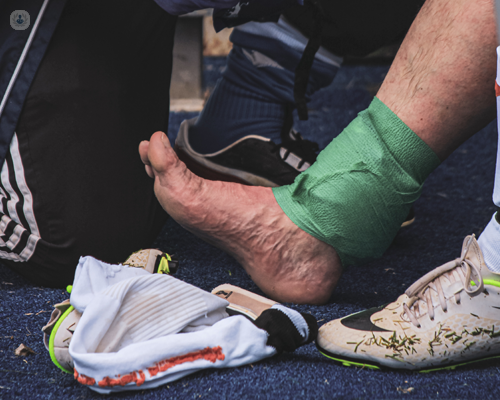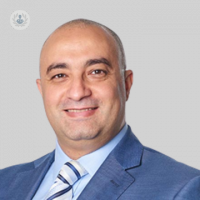From incident to recovery: A holistic approach to Achilles tendon injuries
Escrito por:Achilles tendon injuries are common, but there are various aspects which make each one different. This encompasses the cause, type of injury and considering the patient’s overall health, as well as the treatment route involved. Leading orthopaedic surgeon Mr Hisham Shalaby considers these important points, while also taking a look at recovery from operative treatment, and what can happen if an Achilles tendon injury goes untreated.

What causes Achilles tendon injuries?
The Achilles tendon is the strongest in the body. It takes all your body weight and multiples of this in certain activities, like going against gravity, for example. It's a very common tendon to injure.
Most injuries happen during sports activities and the most common mechanism of injury is the tendon ruptures during what we call eccentric loading. Eccentric loading means that the muscle would be contracting, but at the same time the tendon is elongating and the position of the whole limb is forcing the calf muscles to elongate.
That puts a lot of tension on the tendon, and that's exactly when the tendon ruptures. Sometimes, the tendons can also rupture during day-to-day activities like going upstairs or downstairs.
What are the different types of Achilles tendon injuries?
Achilles tendon injuries can be classified in many different categories. If we think of the severity, for example, we can classify them into partial tears and complete tears.
Partial tears
Partial tears mean part of the tendon is still intact, so obviously here the ends of the tendon don't retract. That's a good indication that healing can happen in a reasonable position without the need for surgery.
Complete tears
Complete tear means that the tendon ends have separated and a gap starts to form between the two ends. If this gap is quite substantial, then the patient might need surgery. Another way of classifying it is looking at the level of where the tear happens. The most common part of the tendon to rupture is the mid-substance of the tendon because there's a watershed effect in this area, and the circulation of the tendon isn't great.
Sometimes, tears and ruptures can happen a bit higher involving the calf muscles. These are usually milder than ruptures of the actual tendon, and tend to heal a bit faster.
Another way of classifying these injuries is by looking at why the tendon ruptured in the first place. It's very rare for a healthy tendon to rupture. Usually there's an underlying pathology. So, things like chronic tendinopathy; a tendon that has been chronically inflamed and unhappy, lays down unhealthy fibres and this makes the tendon a bit weaker. Therefore, the tendon is more susceptible for rupture.
Sometimes ruptures can happen because of an underlying inflammatory problem, for example; rheumatoid patients that can get tendon ruptures.
Can Achilles tendon injuries be prevented, and if so, how?
If we think of what can be done to minimise the risk of a tendon rupturing, we need to think about why did the tendon rupture in the first place.
One of the most common causes is that the calf muscles are very tight, and therefore putting a lot of tension on the tendon. A key thing to prevent a rupture is to make sure that we're working on the calf muscles all the time. They're not tight, and we're doing lots of stretching exercises. This is part of a routine. We all stretch our tendons naturally when we're walking and engaging in day-to-day activities, so it's actually periods of immobilisation, periods of illness for example, when one isn't walking properly or the activity levels have dropped. These are the times when we really need to focus on doing lots of calf stretches.
The second thing that comes to mind is, 'how is the tendon loaded?'. If the tendon is loaded gradually, usually it builds up good fibres that are very strong and can take our weight with no problem. Whereas, if the tendon is loaded over a short period of time that's when problems can happen. I always tell my patients to avoid spikes of activity. We all do that sometimes. When the weather is good, we go crazy with the walking. Then we do nothing for weeks, and then we go on holiday and go crazy again with activities, and so on. This is when the danger can appear, and when the tendon is loaded unexpectedly too much.
I think another thing to think about as well, is how general health can affect the tendon. At this point, what comes to mind is that we always need to control any chronic illness that we have. The most common forms that relate to this problem are things like:
If these conditions are under control, they minimise risks of ruptures, and complications if ruptures do happen.
We also have to think of how much load is applied on the tendon, so looking after your weight is always something that can reduce tension in the Achilles tendon. In this respect, you also need to think of shoes. So, if we're wearing stable and supportive shoes, that again minimises instability. If we're in a situation where the foot is a bit unsteady, naturally all the tendons tighten to give you that stability.
The last thing is how people prepare for activities, particularly sporting activities. If someone wants to run a marathon, they need to build up over months and months of training and very gradual build up until they reach the level required for these activities. We see problems all the time when patients are not prepared for an activity and suddenly take on a challenge, and load the tendon excessively over a very short period of time. That is when tendons can rupture.
What are the treatment options for Achilles tendon injuries?
Based on the severity and level of the rupture, the patient's age and the patient's requirements, we would suggest treating the rupture either conservatively or operatively.
Conservative treatment
Conservative treatment means the patient will go through a period of immobilisation. Usually, the foot is in an equinus position. That means the foot is pointing downward. The approximates the two ends of the tendon, bringing them closer together and the four minimises the gap and allows the tendon to heal without being excessively longer or slack. The patient usually stays in this immobilisation for a period of around eight weeks, during which the foot position is gradually brought back to neutral. Once the healing is okay, the rehabilitation process with physiotherapy begins.
Surgical treatment
The second treatment option is obviously surgical treatment. There are different ways of doing surgical treatment for Achilles ruptures. So, one of these is the direct repair and this is usually recommended when there's no gap, or the gap is very small between the tendon ends. It means tendon can be sutured directly. If the gap is a little bit longer, or bigger, then we start thinking about reconstruction. That's when we use certain techniques to close that gap.
Ultimately, the end of the surgical treatment spectrum is when we do tendon transfers and full reconstruction. That means using a healthy tendon to act as the Achilles tendon. That's usually used when a tendon is significantly damaged, when the gap is too big to bridge, or if the tendon is quite unhealthy. This means it wouldn't be able to function in the normal way.
What are the risks of not treating an Achilles tendon injury promptly?
As I mentioned, an Achilles tendon takes all your body weight and multiples of the body weight during day-to-day activities. So, it's critical that tendon is healthy, strong and of good quality so it doesn't rupture or cause pain.
If a tendon injury isn't treated properly, there are quite a few things that can happen. The most common for example, is when a partial tear is ignored or not healed, or treated properly. What happens is that it can progress to a full rupture or tear. It makes it a much bigger problem to deal with.
Re-ruptures happen when a tendon tear happens and is treated in a conservative way. It heals, or appears to have healed, but the patient started rehabilitation too soon or too fast, loads the tendon back again very quickly, and then the tendon snaps again.
The other problem is if the tendon heals too slackly. That can make the tendon weak, and the calf muscles can become weak. This is a very big problem because it means that one cannot push off with good strength. This would impact the ability of patients to engage in very basic activities like going upstairs, for example. They might find they can't run; they might find they can't walk for a longer distance, and obviously might need treating operatively.
Also, a lot of patients after Achilles tendon injuries can have pain. This can happen again for a variety of reasons. One of which is if the tendon is too tight, and is still under a lot of tension.
What's the recovery process like after Achilles tendon surgery?
Recovery after surgery is pretty similar to conservative treatment where the patient still has to go into a period of immobilisation. The only difference is, is that it's a little bit faster to return to activity and sports.
Generally, that involves a period of six to eight weeks of immobilisation in a boot. Usually, the initial period involves wedges under the heal, in order to raise it. That tends to offload the stress applied on the tendon, and any repair under four makes it less likely for re-rupture to happen. Gradually the foot is brought downward again in a more neutral position, and then finally the patient engages in a rehabilitation programme with physiotherapy. That usually involves work on the core muscles, involves work on the calf with lots of stretching exercises, and strengthening exercises to the tendons. Finally, proper strength training and balance exercises.
If you require expert treatment for Achilles tendon injuries, you can arrange a consultation with Mr Shalaby via his Top Doctors profile.


